A list of friendly characters found in Disney's Mickey Mouse Comic Universe.
Click here to return to the main list.
- Click here to go to the protagonist list.
- Click here to go to the animal list.
- Click here to go to the antagonist list.
- Click here to go to the fiend list.
- Click here to go to the otherworlder list.
- Click here to go to the subseries character list.
- Click here for more options.
Keep in mind that since the characters and series have been around for so long, whether a character displays certain traits or not in any given story largely depends on the artist, the writer, or the time period.
Neighbors
Butch

A former crook who reformed thanks to Mickey's intervention.
- The Bus Came Back: Butch was used four times by Gottfredson and had a few appearances in comics from Great Britain before leaving the stage in the late 30s. He returned in 1996 and has been a regular since.
- No Social Skills: On occasion, Butch's low class upbringing and lack of education cause him to get into situations he can't handle or understand. It's less that he has no social skills as that he has social skills only fit for a part of society that he's largely left behind.
- Perpetual Poverty: He usually doesn't have a steady job, lives in a shack, and has one problem or another making ends meet.
- Reformed, but Rejected: A recurring topic in Butch's life is that he formerly was a crook and has to face distrust over that as well as being at risk of being pushed back into his old habits. "Future Imperfect" in particular tells of this struggle.
- Reformed Criminal: Aside from his initial story, he's also helped Mickey solve other cases such as in "Schoolgirls" and "Time Marches Off".
- Terrible Trio: Formed by Butch, Snake, and the other guy. Could somewhat argued to be Combat, Diplomacy, Stealth in the order Snake, Butch, and the other guy.
Gideon and Gertie Goat

A goat couple. Gideon is usually a farmer, but sometimes a police officer.
- Alliterative Name: Gideon and Gertie Goat.
- Hair-Trigger Temper: In "The Great Orphanage Robbery", Gideon proudly points out he was the first to want to lynch Horace.
- Perpetual Frowner: Gideon, but mostly in his police officer appearances.
- Out of Focus: Both characters were only used during the 30s, Gideon having slightly more appearances than Gertie.
Mickey's Unnamed Neighbor
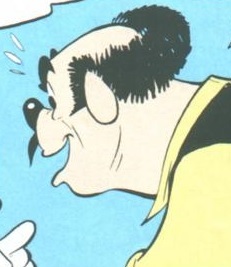
Mickey Mouse's next door neighbor. They hate each other passionately.
- No Name Given
- Sitcom Arch-Nemesis: He and Mickey, of all people, often bicker with and harass each other.
- Suspiciously Similar Substitute: He's virtually Mouseton's version of Jones, Donald's neighbor.
- Trademark Favourite Food: Apple truffles. But to make them, he needs apples from the apple tree standing partially on Mickey's ground. That, of course, causes full-fledged war between them.
Patricia Pigg
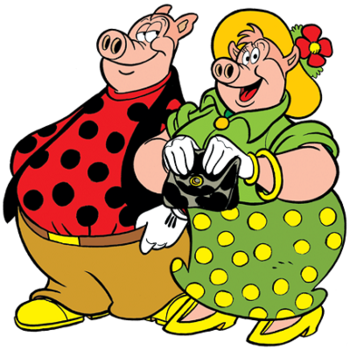
A pig couple. They've got two children, a girl and a boy, named Peggy and Plato.
- Alliterative Name: Patricia and Percy Pigg.
- Damsel in Distress: Half of Patricia's modern appearance (which aren't many, mind you) are in Dutch Mickey Mouse riddle-type comics. She's either the victim or part of the crowd anxiously awaiting Mickey's conclusions.
- Gossipy Hens: Patricia with Minnie Mouse, Clarabelle Cow, Daisy Duck, and Clara Cluck. It's another factor as to why she's been slightly more enduring than her husband.
- Happily Married: Patricia and Percy are among the very few couples in the neighborhood as far as the comics show.
- Nuclear Family: With a daughter and a son. No pet though.
- Out of Focus: Percy's only appeared in a handful of comics after the 50s.
- Sudden Name Change: Before settling on "Pigg", the last names "Van Pork" and "Pig" also got used.
Pop Weezil

An elderly man who is the town's station agent, motorman, postmaster, constable, fire chief, and justice of the peace. Mickey sometimes works for him.
- Cool Old Guy: With as many jobs as he manages at once and his role as somewhat of an Eccentric Mentor to Mickey, he qualifies. He has some Grumpy Old Man traits too in the pride department, best displayed when he takes offense when he and Mickey extinguish a fire threatening Clarabelle's house by bumbling. As he puts it:Pop Weezil: "Another hour or so an' I'd of had her out in my own way!"
- The Bus Came Back: He got to star in a story again when "A Bomb Deal" was published in 1997, 65 years after his then-final appearance. He's yet to make a second comeback.
- Jack of All Trades: As per the intro, he's the town's station agent, motorman, postmaster, constable, fire chief, and justice of the peace. Or was at his debut, anyway.
- Hanging Judge: For pragmatic reasons. There was one guy in "Fireman Mickey" he fined five dollars for speeding. The guy only had a ten on him and Pop Weezil could't change, so he upped the fine to ten dollars.
Annabelle Mink
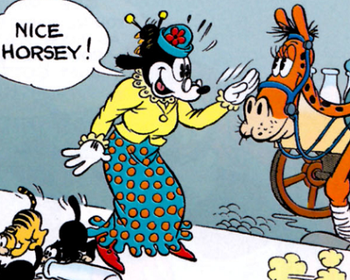
Annabelle came to live in Mouseton in Clarabelle's boarding house, finding a kindred soul in her.
- Inexplicably Tailless: Annabelle has a tail in "Clarabelle's Boarding House", but not in her following appearances. It isn't explained whether her model just got updated or if she hides it under her skirt later on.
- Old Maid: She regrets not having found herself a man yet.
- Only Sane Man: Among Clarabelle's boarders, some 8-10 convicts, a guy who eats for ten and doesn't see a problem sawing himself a bigger door without asking, and noisy musician who is annoyed by the slightest sound not made by him, Annabelle and her desire for a husband is the only one not driving Clarabelle to despair.
- Theme Naming: The likeness of Annabelle's name to Clarabelle's might be intentional given the character was introduced as an Old Maid in the same story that set things up for Horace's and Clarabelle's wedding.
Timothy Shoebuckle

An elderly couple involved with dog races. They're the owners of Zowie, the fastest dog in Mouseton.
- Happily Married: Mrs. Shoebuckle has Mickey promise he won't tell Timothy of any bad news while he's sick, arranging his care, shouldering their worries, and keeping the mortgage holder at bay all on her own in the meantime.
- No Name Given: Mrs. Shoebuckle's forename is not mentioned.
- Taking the Heat: Mr. Shoebuckle knew there was a risk if he'd allow Pluto to enter the track's opening race, but he couldn't bring himself to send him away when Mickey came into his office with all naive optimism. So he gave them an entrance coupon and Pluto went on to singlehandedly ruin the entire event. The organization couldn't do more than permanently ban Mickey, but Shoebuckle was fired. This in turn caused the Shoebuckles further trouble with their mortgage, which could only be paid if Zowie would win a big race upcoming. Still, they didn't hold it against Mickey and even let Pluto become Zowie's training companion so Mickey could go on training him at the track.
Ellsworth Bheezer

Originally introduced as Goofy's pet mynah bird, Ellsworth soon became more anthropomorphic, switching between Talking Animal and full-fledged Funny Animal to the point where he can communicate effortlessly with both animals and humans. His rarely heard last name was first mentioned in a 1955 gag comic.
- Arch-Enemy: It's not clear if it's the same one every time, but in the 50s Ellsworth often had violent confrontations with a hawk.
- Attention Whore: Overlaps with Vicariously Ambitious. Showbiz is a big part of Ellsworth's character. According to a 1950 gag comic, he spent three years as a marine mascot, while another comic that year has him accept an agent to return to the stage to bail out only when the agent overworked him. A 1951 comic has him reunite with two old friends who do standup comedy and a 1953 has him visited by Murphy's Marvelous Mynah Birds, equally old friends. Another 1951 comic sees him apply for a television production, but quit because he wasn't treated respectfully. A 1954 comic has him purchase a theater and wrestling contracts solely to spite the former owner. Twice, in 1953 and 1954, he started and directed a singing group, while in 1955 he coached a single meadow lark who fired him when he became The Prima Donna-by-proxy. In 1956 and 1959, Ellsworth gave televised ventriloquism a try, but the dolls were as spotlight-hungry as he was. He later helped Morty and a friend sell their lemonade by making a Wild West show out of it. And in 1957, he tried to train cats for a circus act, which fell through when he forgot to bring them yummies.
- The Barnum: Unless Ellsworth has a soft spot for someone, he's going to treat a sucker like a sucker. And even being in his graces is no guarantee he won't exploit a weakness. It sometimes moves to Honest John's Dealership territory when he turns his tricks into business ventures.
- Battle Butler: He temporarily had one, named Fettle, in a 1958 comic. He was mightily impressed by his courage.
- Chick Magnet: Ellsworth's had a new romantic interest every time his love life has come up, which was a regular occurence in the Sunday strips. Most of them were regular birds, but he's also flirted with humanoid animals. Interspecies Romance is at play because Ellsworth only once has been portrayed with another mynah, that being in a 1992 comic. In the Sunday strips alone, he's flirted with a peacock... with a tail, a lovebird (1950), a crane (1952), a pigeon (1953), another pigeon, two parakeets, and a bird-of-paradise (1955).
- Color-Coded Characters: Done in most versions of a 1951 newspaper comic in which Ellsworth hangs out with his old friends Ed and Ted, two mynah birds with a comedy routine.
- Commuting on a Bus: Depending on the country; it leans more towards Out of Focus with a bit of The Bus Cameback in the USA. Ellsworth's big decade, from an American perspective, were the 50s. When Bill Walsh stopped writing him, the character was picked up by Brazil, Italy, and later the Netherlands and France, the latter being the country he's most popular in. In regards to the USA, Ellsworth did not return until Gemstone in 2005/6 translated three stories he makes an appearance in, and then it took until 2016 for another such translation. In Italy, "Pippo e il ritorno del Gancio" emphasized Ellsworth's tendency to fly off and do his own thing before returning to Goofy with the explanation that he'd been off trying out several shady businesses. This characterization was then used in 1975, after a few years of absence, with the story being that he'd joined the Foreign Legion. During this time, he'd adopted Ellroy, an orphaned mynah bird, who more or less took over from Ellsworth thereafter.
- Deadpan Snarker: His sarcasms are biting, though Goofy rarely catches on.
- Good Luck Charm: Goofy bought Ellsworth when he was down to $1.79 and the pet shop advertised a mynah for $1.79, thinking of it as a sign. Ellsworth wasn't in the least amused about being bought by a poor guy who kept talking about his belief that luck would change for them. Still, Ellsworth was there to take a phone call from the "Try And Get It" jack-pot radio show and answered the $200,000 question correctly.
- Furry Confusion: Polly Wants a Microphone at its finest. Ellsworth was bought by Goofy at a pet store, sometimes has to flee from hungry cats, flies like a real mynah, and isn't allowed in restaurants or theaters, yet he wears a shirt and occasionally a hat, has studied at Yarvard, has taken several jobs, and has even been arrested a couple of times. This is never commented on but presented as completely normal. The height of absurdity this reaches is in a 1952 comic where Goofy forbids Ellsworth from going out that night, so Ellsworth buys a stuffed mynah and dresses it up as himself to trick Goofy into thinking he's at home.
- I Am Not Weasel: A minor recurring gag in the early comics is that Ellsworth is mistaken for another kind of bird, usually a parrot, but he's also been called a quail or any type of blackbird. He takes offense.
- Identical Stranger: Not all that weird considering he's an animal. He's been tricked by another mynah bird into switching places twice, once in 1952 and another time in 1956.
- Papa Wolf: For all his brass, Ellsworth has a soft spot for little ones. Aside from adopting Ellroy, Ellsworth has twice protected a nest of chicks from a cat, babysat another nest (that was not entirely voluntarily), saved an abandoned egg from winter's cold and hatched and raised the chick, collected a penguin egg that fell off the truck to the zoo and hatched and raised that one too, took in a baby elephant, and even protected kittens once. The only one whom he kicked out was a (possibly mature) canary he had bought to learn to speak, only to find it wouldn't shut up afterwards.
- Pet Heir: In a 1953 gag comic, Ellsworth inherits $50.000 from a millionaire he used to belong to. He donates it to the Institute for Ornithology because the money robs him of his old charm.
- Reformed Criminal: Type Reformed, but Not Tamed. It's never given any detail, but some comics — not to mention his Street Smart shtick — point at a past Ellsworth for the most part tries to keep behind him. Sometimes it catches up with him, like in a 1950 comic which has his cousin Limberlip visit. Limberlip has dirt on him, which makes Ellsworth scared to take a stance against him until Limberlip takes it too far by flirting with the girl next door. In "The Bridge on the River Ai-Yai!", the past Ellsworth's former friend Flappity McFlop is part of does not contain crime as far as is mentioned, but the dialogue suggests there's been other things simply not as significant as the bridge incident. It takes Mickey and Ellroy finding evidence of Ellsworth's innocence before he dares to cut off Flappity. All the same, old habits are hard to unlearn, as shown in a 1951 comic where Ellsworth sneaks into a circus on argument that "[he]'d pay to get in... but it's against [his] principles!" On occasion, like in 1950 and 1959, Reformed, but Rejected kicks in when he's accused of theft committed by birds that look like him, such as crows.
- Renaissance Man: Various Sunday strips have depicted him as an artistic genius who can whip up a priceless painting in an afternoon, a math genius, an omniglot, a financial genius, a strategist, a deputy sheriff, and more. Despite housing with a Cloud Cuckoo Lander-type genius, Goofy's hidden depths have never come up when he and Ellsworth share a comic.
- Robot Me: Ellsworth built himself one in a 1990 gag comic. He put it with the trash after it wouldn't shut up.
- Sixth Ranger: Plans for what would become Mickey, Donald, Goofy: The Three Musketeers started in 1983, with the role of fourth musketeer going to José Carioca. In contrast, a 1994 cover of Le Journal de Mickey made in honor of the 1993 movie depicts Ellsworth as the fourth musketeer, reflecting his popularity in France.
- Token Evil Teammate: The closest to one that exists in Mickey's immediate circle. He's egocentric, vengeful, spiteful, violent, mischievous, a Vitriolic Best Bud towards Goofy who has no means to defend himself, but he's also loyal, a debt payer, a Papa Wolf, and ultimately a Jerk with a Heart of Gold.
Alvin
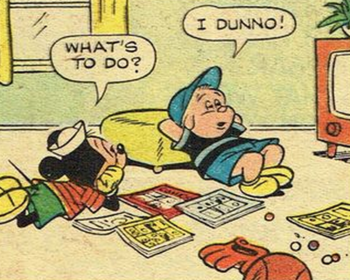
One of Morty's closest friends.
- Big Brother Instinct: Alvin's got an unnamed younger brother he sometimes has to look after.
- Expy: To Ferdie in the sense that he was the first of Morty's two friends that were introduced to give him a companion while Ferdie was out of the picture.
- Fat Best Friend: Type A, although not with a personality that's necessarily distinct from Morty's.
- Out of Focus: His last appearance was in 1988.
- Treehouse of Fun: Alvin and Morty (and some other friends that weren't recurring characters) built one in a 1964 comic. Millie sometimes joined them when they were hanging out there.
Millie
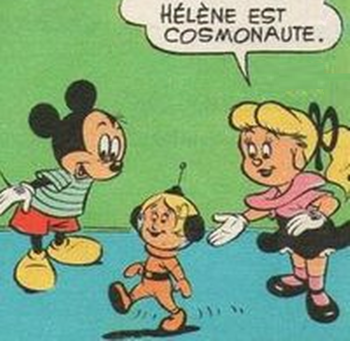
One of Morty's closest friends. She collects dolls.
- Distaff Counterpart: To Alvin and by extenstion Ferdie in the sense that she was introduced as a companion to Morty in line with Alvin.
- Puppy Love: She and Morty like each other a lot and occasionally talk about their future together.
- One of the Boys: She is this some 50% of her appearances, including the rare times it's Morty and Alvin who adjust to fit her preferences. One 1966 gag comic even suggests a deliberate gender role change on Millie's part where she has "girl" days and "boy" days.
- One-Steve Limit: Averted. She shares a forename with Minnie's niece. Confusingly, a 1966 gag comic shows Millie spending time at Minnie's house without clarification on their relation.
- Out of Focus: Her last appearance was in 1987.
Glory-Bee

Goofy's love interest whose spotlight era was in the 70s. As per "The Case Of The Abominable Snowman", she's a balloonist.
- Butt-Monkey: By far most of Glory-Bee's appearances are newspaper gag comics starring only her and Goofy. Because Goofy's thing is to bumble, Glory-Bee's thing becomes to be on the receiving end of his bumbling.
- Love Triangle: A few comics depict her and Clarabelle as romantic rivals for Goofy.
- Out of Focus: Glory-Bee's only appeared in a handful of comics after the 70s.
- Theme Naming: Combines with Punny Name. Hers is a play on "Glory be!", a by now dated expression to indicate surprise. Glory-Bee and Goofy decide they are a romantic match because their names are a match.
- Ugly Guy, Hot Wife: She's a whole lot prettier than Goofy.
Ellroy
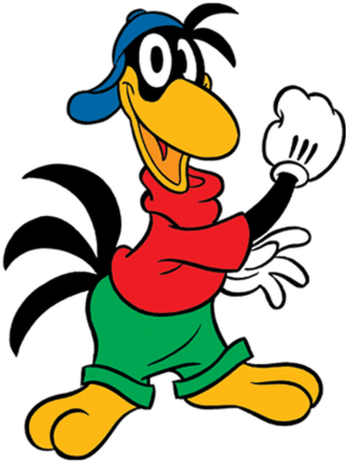
An orphan rescued by Ellsworth during his time at the Foreign Legion and later adopted. Because Ellsworth travels a lot, Ellroy often stays with Mickey or Goofy and acts as Mickey's sidekick on adventures.
- Bratty Half-Pint: Sometimes lapses into this, when he's not being a Cheerful Child.
- Cheerful Child: For the most part. He's good-natured and upbeat, and while he does have a strong mischievous side, he's on the whole far less trouble than Ellsworth.
- Composite Character: A translation version. Since he and Ellsworth seldom appear in the same story, some translations of the comics (like the Norwegian one) tend to treat them as the same character. On the rare occasion when a story featuring them both is translated, Ellroy is treated as the character we know while Ellsworth is re-imagined as his shifty but loveable uncle.
- Deadpan Snarker: Not to the lenghts Ellsworth takes it, but he definitely has his moments.
- Flight: His biggest asset is that he can fly.
- Furry Confusion: More seldom, and to a lesser degree than Ellsworth, as he's generally presented as more anthropomorphic, but it's still there. His most notable "animal" trait is that he can fly, something that the other human stand-in birds of the comics (like for example Donald Duck) can't do, and he has on occasion disguised himself as a normal bird in order to spy on the bad guys.
- Generation Xerox: Despite not being biologically related to Ellsworth, he looks and even acts an awful lot like him — he is a little smaller, has a smaller beak and generally wears pants and gloves, but otherwise the two are so similar that many fans have thought they were the same character — especially since they very rarely appear in the same story together.
- Happily Adopted: In his first appearance, he wasn't aware that Ellsworth wasn't his biological father and only found out when he overheard Ellsworth telling Mickey the story of how he had found the kid in an abandoned nest in the desert. Ellroy's reaction? He went out and got a large bottle of sparkling cider, so he could toast Ellsworth and celebrate his father for being such a hero.
- Hero-Worshipper: To Ellsworth, in the rare stories they appear together. He admires his father over everything.
- Large Ham: Not all the time, and since he's a comic book character it's not always that noticeable, but he's got a bit of a fondness for Chewing the Scenery, especially if he has an audience.
- Motor Mouth: He's a bit of a chatterbox; he can go on at length about pretty much any subject if you let him.
- Sidekick: Occasionally to Mickey.
- Suspiciously Similar Substitute: For Ellsworth. Romano Scarpa even admitted that he'd introduced Ellroy as a toned-down replacement for Ellsworth, who wouldn't overshadow Mickey; "Ellsworth is too strong a character to play as a sidekick. He's got to be the star. Ellroy is duller, and highlights Mickey's role."
Sieb Sik
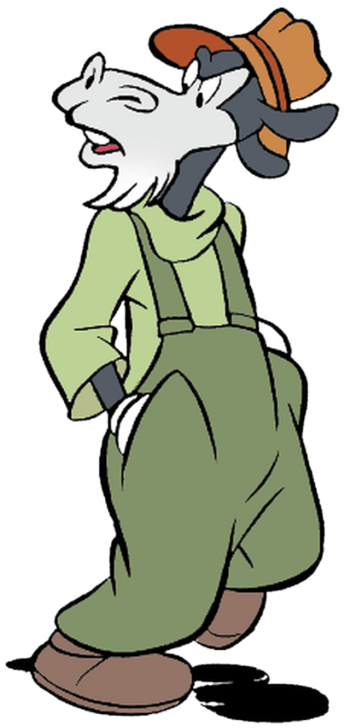
A Dutch-original character ("sik" means "beard of a goat") who is good friends with Horace and Clarabelle.
- Accidental Public Confession: In his debut comic. He went to a costumed party with Clarabelle pretending to be Horace because Horace didn't want to go and paid him to keep Clarabelle fooled. Worried his voice will give him away, he barely speaks, prompting Clarabelle to exasperatedly comment that he's acting all weird like Sieb would. Sieb's reaction reveals his identity.
- Alliterative Name: Sieb Sik.
- Get-Rich-Quick Scheme: He and Horace pull a few of these.
- Satellite Character: To Horace and Clarabelle. He was introduced at the same time as Maw Cow and Paw Horsecollar.
- Voice of Reason: To Horace. Not that Horace listens.
Friends
Captain Nathaniel Churchmouse

A sea captain who was thought dead for fifteen years until Mickey found him half-crazy while stranded on a desert island. After a fortunate coconut bump, Captain Churchmouse regained his sanity and reunited with his wife who had been waiting for his return. Ever since, he has enlisted Mickey's help when a voyage seemed to be a tough one.
- Affectionate Parody: Nathaniel is one of Ben Gunn.
- The Captain: Captain Nathaniel Churchmouse, although it varies whether he fulfills the trope's role or not. Only in "Mickey Mouse Sails for Treasure Island" is he shown as leading a crew, anyway.
- Chuck Cunningham Syndrome: Gottfredson always gave Mrs. Churchmouse some panels if her husband was in the story and emphasized how the couple would never be apart again. Later writers might as well never have seen those panels. In painful contrast, Spooks, the gorilla explicitly returned to his home in Africa, has been picked up to star alongside Nathaniel some more.
- Happily Married: Few couples in the comics are as idealistic as the Churchmouses.
- I Will Wait for You: Mrs. Churchmouse waited fifteen years for her husband to return.
- Mighty Whitey: The local population of the titular island treated Nathaniel as a god because of his unpredictability. Mickey even refers to him as a "white god".
- The Mutiny: It was a mutiny led by Peg-leg Pete and Sylvester Shyster that got Captain Churchmouse missing for years.
- No Name Given: Mrs. Churchmouse's forename is not mentioned.
- Pre-Insanity Reveal: It takes a bit before Mickey understands that the hermit he's dealing with is Captain Churchmouse and gets him back to his senses.
- Rags to Riches: The Churchmouses deal with poverty each in their own way, but at the end of "Mickey Mouse Sails for Treasure Island" they reunite and get a treasure out of the adventure too.
- Reports of My Death Were Greatly Exaggerated: Even Captain Churchmouse himself thought he was dead, showing Mickey his grave and talking about what a brave man he was back when he was alive.
- Robinsonade: Churchmouse from his time stranded in Africa. He wasn't alone per se, as there were people native to the area around, but he wasn't quite one of them, being treated like a spirit.
- Suspiciously Similar Substitute: Mickey's uncle Churchmouse in "Twenty Fathoms to Treasure".
- Walking the Earth: Implied with a dash of Cool Old Guy and Cool Old Lady. What's the first thing they do when reunited after all that happened? Set out for a boat trip for at least four months according to "Mickey Mouse Joins the Foreign Legion"! What do they do when they get rich thanks to the treasure in "In Search of Jungle Treasure"? Sail around the world all by themselves in a brand new boat!
Sam

A young boy who works at the Pooch Park Race Track.
- Baker Street Regular: Has shades of this doing odd jobs around the track, assisting the heroes, and keeping his ears open. No information on his family is provided in his one comic appearance.
- Children Are Innocent: After Shoebuckle's resignation, Sam was the only person at the race track that treated him and Mickey without ill will.
- Mouthy Kid: He supports Shoebuckle, Mickey, and Zowie, but he makes clear his two bucks are on Black Lightning because he has inside information.
Mac MacCorker
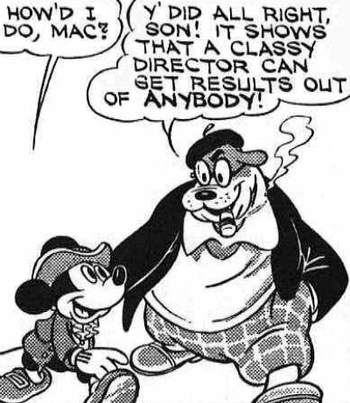
A film director at Disney Studios for whom Mickey occasionally works.
- The Bus Came Back: He had two appearances in 1938 and finally returned in 2002's "The Secret Scooper", making for a difference of 64 years.
- Friendly Rivalry: Mac's and Mickey's friendship stands out for the near-constant banter the two engage in, either to pedestalize themselves or to take the other down a peg. It is all unquestionably in good fun. Take the lines of Mac's first on-panel appearance (to which Mickey admits defeat!) for example:Mickey: "Oh-oh! Directed by the "great" MacCorker! What chance has this picture got?"Mac: "A mighty swell chance —- if we had a good star!"
- Leaning on the Fourth Wall: "The Brave Little Tailor" is an adaptation of Brave Little Tailor. Because the newspaper comics formed one long storyline, the tale was framed as a movie Mickey and his friends were actors in. Mac belongs to the framing segment, which was maintained for "Mickey Mouse Meets Robinson Crusoe", and thus by nature is a fourth wall-leaning character.
Gwen

Also known as Foreman 82, Gwen is a mechanic at Phree Air Craft Co.. Mickey was her responsibility for a short while.
- Da Chief: She is merciless towards Mickey, who constantly thinks he does his job at a commendable pace but truthfully can't even keep up with the senior workers. But she also spends her own free time on teaching him to do the work better.
- Prim and Proper Bun: She's a foreman and wears her hair up like this.
- Samus Is a Girl: Played with. Mickey only knows shortly of Foreman 82 before meeting her, embarrassingly asking her where he can find 82 before noticing the badge on her uniform. The joke is less on this instance than it is on Mickey's obliviousness beforehand that he would be working predominantly with women what with so many men off to war.
- Wrench Wench: She doesn't do that much herself because her task is to make sure others do their work well, but when teaching Mickey how to do better she shows how capable she is with a good set of tools.
Yoyo

A jive-talking Native American ("Zoot Sioux") who went to get help for Mickey's cousin Carrie.
- Aborted Arc: At the start of the story he shows up at Mickey's doorstep asking for help for his cousin Carrie. Carrie's fate remains a played-up mystery throughout the story until it is revealed she got married and willingly sold her ranch to the villains. This does not fit the narrative up to that point, such as Beamish getting nervous when Mickey asks about the ranch's notable feminine touch when there's only men working there. As such, Yoyo's connection to Carrie and why he was asked to go to Mickey in the first place is not explained.
- Badass Native: Mickey would've died several times if not for Yoyo.
- Deadpan Snarker: He has zero time for nonsense other than his own. The image used for this entry has him and Miss Laramie observing a fistfight between Mickey and Beamish.
- Jive Turkey: He solely speaks in slang, to the point that early in the story Mickey has Johnny Jitter come over to translate.
- Sidekick: To Mickey.
The Bernards
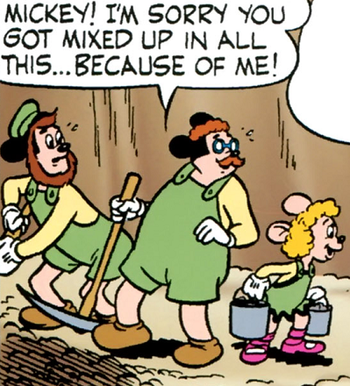
Friends of Mickey and Goofy. Samuel T. Bernard was a Professor of Geology at Mousechusetts Tech before becoming an inn keeper at Maneeto Mountain. His brother, Matthew, is a captain and seemingly a regular caretaker of Samuel's daughter Melody.
- The Captain: Matthew is one, caring but with a temper. Overlaps with Father Neptune as per his own words:Matthew: "For forty years of skipperin' I knowed the sea was a demon, but it couldn't scare me' so don't get the idea a blockhead mountain's gonna do it!"
- Cartoon Creature: While Samuel and Matthew are easily recognizable as mice, Melody is not. She has the ears, but she lacks the framed face fur pattern her elders have. What she does have is a tail that seems to belong to a cat. Possibly, her mother was feline.
- Missing Mom: Samuel's wife and Melody's mother is never mentioned. She might be dead if Matthew is Melody's second caretaker.
- Plucky Girl: Melody is probably around 15 years old and takes the disappearance of her father remarkably well. She cares for her uncle as well as he cares for her and when he disappears she refuses to let Mickey search for him alone. She is reunited with her family when they're all captured by Pete and during that time is the most positive there's a way out.
- The Professor: Samuel is a Professor of Geology. It is his discovery of invizium and how to handle its effects that set the events behind "Man-Eater Mountain" in motion.
Doctor Proctor

The general practitioner Mickey, Goofy, and the others visit.
- Depending on the Artist: Starting 1975, Proctor would occasionally be drawn with a more prominent moustache and gradually become more dogface-like in design.
- Out of Focus: He hasn't been used in a comic since 1989.
- The Medic: It's a good thing he's so good-natured, because his clients come with the weirdest of ailments. Minnie once saw him for getting her face full of spines from talking to her cactus. Goofy once arrived with a buzzing head — turned out there was a fly stuck under his hat. And Mickey once called him over just so he could make his excuse as to why he couldn't attend a tea party look real.
- Running Gag: Proctor really loves golf. Most of the strips he appears in have jokes that center around the patients, but Proctor's recurring schemes to get out of work so he can go play golf are all on him.
- Super Doc: Insofar that he is expected to (and often can) also heal pets and repair broken objects.
Patti Poodle

A friend of Minnie and one-time date of Goofy.
- Alliterative Name: Patti Poodle.
- Eyes Out of Sight: She has long bangs that cover her eyes. Her eyes are only visible twice when she manually lifts her bangs to get a better look.
- Funetik Aksent: She's French, so her accent is marked this way. Poirot Speak also creeps in, like referring to Goofy as "ze Goofee" and saying "buffaloed" instead of "befuddled", but it's mild.
- Huge Guy, Tiny Girl: She's at most a head taller than Minnie and went on a date with Goofy that turned into them busting two fences together.
- Red Herring: Either a bad one or an Aborted Arc. The four villains of the story are two jewel thieves and two fences. The jewel thieves, for unexplained reasons (possibly safety by reputation), are pretending to be Gaston Tooshay, a well-known international jewel thief. This Gaston Tooshay does not show up in the story and none of the four crooks knows what the master criminal looks like. Tooshay (phonetic transcription of "Touché") is evidently French, which raises the suspicion until the end pages that the French Patti is going to turn out to be "him". This suggestion grows when Patti eagerly goes with Goofy to trick the fences, claiming she knows "how these criminals behave, [because she] read ze book once!", and objects to being called his moll. However, nothing comes of it. There's no reason or payoff to the French angle, Patti's enthusiasm for going after the fences while everyone else is cautious just is a thing, and Gaston Tooshay remains an informed villain.
Slim
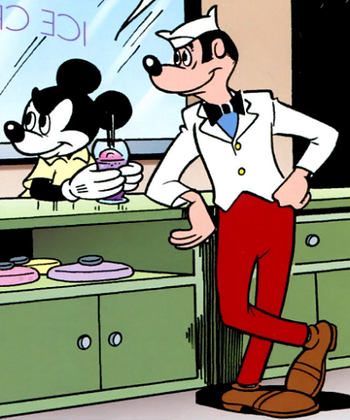
The soda jerk at an establishment Mickey and his friends often visit.
- Depending on the Artist: Slim doesn't have a set design and changes looks not only between artists but also between appearances by the same artist. The design in the image used is from "The Man That Wasn't There!" with art by Tony Strobl.
- Malt Shop: The place Slim runs, with elements of Good-Guy Bar. The only one to hop by to disturb the peace is Mortimer, but usually he does so in a The Friend Nobody Likes manner.
- Out of Focus: He hasn't had a comic appearance since 1976, which is somewhat odd since Egmont took the "Mickey and his friends hang out to drink milkshakes" concept in the 2000s and made it a recurring event in their comics.
Génio

Ellsworth's cousin (who's named Génius in France; Génio currently has no English name) who lives in Venice.
- Expy: To Ellsworth, of course.
- Furry Confusion: Same as with Ellsworth. Génio exists at a shifting average between animal and person.
- Man of the City: Lightly to Venice, which is part of the reason he teams up with Goofy and Mickey when a monster is spotted in the city's canals.
Petulia O'Hara
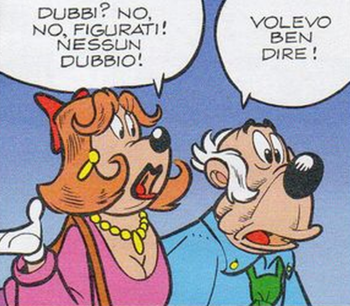
The wife of Chief Seamus O'Hara. They enjoy a happy marriage.
- Ascended Extra: Chief O'Hara first made reference to his wife in "The Gleam" and would periodically do so for 54 years more in stories such as "The Santa Claus Bandit", "Mickey's Dangerous Double", "The Kid Gang", and "The Mystery of the Robot Army!" until Petulia was made into an actual character in "Basettoni e la dieta da fame".
- Happily Married: She and Seamus enjoy a good marriage in which at most Seamus could spend a little more attention to her than to his work, but she's always ready to help him when a case gets the better of him.
- Housewife: She is this, which in turn is the reason she doesn't show up much. She has picked up some police techniques from her husband like Perp Sweating that she sometimes makes use of to accomplish one goal or another.
- Nuclear Family: Abandoned. "Mickey's Dangerous Double" makes mention of a young son, whereas "The Kid Gang" has the O'Haras think of adopting. While mentions of Seamus's wife have evolved into the character Petulia, the possibility of them having children appears to no longer apply.
- One-Steve Limit: Averted. Petulia O'Hara is mostly known as just "Petulia", which is rather similar to "Petula", the name of Pete's sister.
Panda boy
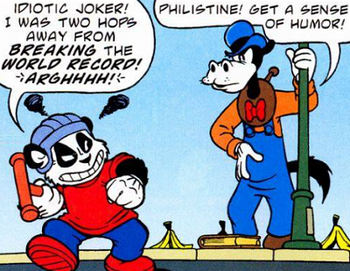
A boy who got in a fight with Horace over world records.
- Intergenerational Friendship: The boy is probably about 16, while Horace is in his (late) 30s. They start out as enemies, but over the course of the boy's debut comic gain mutual understanding.
- No Name Given: As follows from the folder's clumsy title, the panda boy is not named in his one comic.
- The Rival: To Horace in getting a world record to his name.
- Spanner in the Works: Motivated by Revenge. The panda boy was trying to break the world record for the pogo-stick hop count when he failed at two hops short due to Horace's Banana Peel prank. His words of anger brought Horace the idea to go for a world record himself, but every single one of his attempts was sabotaged, sometimes at the last minute. He initially suspected Clarabelle, with whom he had a bet, but then the panda boy revealed himself, pointing out that Horace sabotaged him first and stole his world records book. Horace couldn't argue with that.
Mouseton Police Department
Detective Casey

A competent but glory-hungry detective of the Mouseton PD that's often shown up by Mickey.
- Ascended Extra: Originally a supporting character in Mickey Mouse-stories, in Italy he nowadays stars as the protagonist of his own stories without Mickey around, often paired up with Brick Boulder.
- Butt-Monkey: He has traces of this.
- Character Exaggeration: In "The Plumber's Helper", there were a few jokes about Casey being less smart than Mickey, but overall he was competent, fully trusted Mickey, and had no objections to letting Mickey lead the investigation. In "Mickey Mouse Outwits the Phantom Blot", these positive traits were mostly transferred to Chief O'Hara and Casey's lacking smarts compared to Mickey were played up and emphasized with detrimental arrogance.
- Clueless Detective: Leads into Dumbass Has a Point. Casey can be considered the lawfully appointed parallel to friendly neighborhood Goofy. His main role is to be the one who draws the wrong conclusions, follows the wrong clues, and in meaning well gets in the way of the solution. However, at those times Mickey gets overwhelmed, having Casey around is vital to not dying and getting the baddies behind bars. For example in "Mickey and the Grey Scourge", while Mickey's friends were failing to tell him from his Criminal Doppelgänger Miklos, Casey dropped in with Pluto to recognize by smell. Another time in "Quadruple Threat", after initially not believing Mickey's claims something was off about a new radio station, Casey did some thinking on his own and came to the same conclusion as Mickey, rushing to the relevant address in time to pull Mickey out of an Enemy Civil War.
- Inspector Javert: Some stories have him in this role. If Mickey or one of his friends are framed or wrongfully accused of a crime, Detective Casey is always the one most gung-ho about bringing them in.
- Inspector Lestrade: Especially in older comic books and in Italian stories: When he stars in Mickey-as-detective stories he usually acts as the Inspector Lestrade to Mickey's Sherlock Holmes.
- Jerk with a Heart of Gold: He's grouchy, impatient and much too quick to jump to conclusions, but he is, when it comes down to it, an honest cop who genuinely wants to uphold law and justice.
- Miles Gloriosus: Occasionally, Depending on the Writer
- Small Name, Big Ego: Again, occasionally.
- Those Two Guys: Sometimes forms this with Rock Sassi.
- You Don't Look Like You: In "Goofy's Mechanical Wizard", Casey is drawn far more human-like, having only a nose and ears to show he's not actually a human. He lacks the distinctive lips, snout, and flair of movement. Were it not for his name being given, he'd be unrecognizable.
Chief Seamus O'Hara

Chief of the Mouseton PD, he's friends with Mickey Mouse and the two sometimes ask each other for help. He's married to Petulia.
- Da Chief: Though of the less-blustery kind, especially towards Mickey and Goofy. The one he's most strict with is Detective Casey.
- Depending on the Artist: O'Hara has been depicted with either white hair or brown hair. Most artists favor white hair.
- Friend on the Force: Which has helped Mickey in many cases.
- Happily Married: Has been so ever since "The Gleam", although his wife did not become a character until "Basettoni e la dieta da fame". The most strain they show in stories Petulia appears in is that she wishes he'd be a little less married to his job.
- Named by the Adaptation: Gottfredson only gave the character his last name, O'Hara. Some translations and later comics to use the character gave him first names like Albert (France) and Konrad (Sweden). He was given a first name for use in the anglosphere in "With Friends Like These...".
- Not So Above It All: Usually a serious and calm character, he can get into the antics of his men, or even crazier, at a moment's notice, such as when a creative judge sentenced Pete to work as a cop and O'Hara partnered him with a new officer with Obsessively Organized tendencies.
- Nuclear Family: Abandoned. "Mickey's Dangerous Double" makes mention of a young son, whereas "The Kid Gang" has the O'Haras think of adopting. While mentions of Seamus's wife have evolved into the character Petulia, the possibility of them having children appears to no longer apply.
- Officer O'Hara: As if he himself is not enough, in the "The Phantom Fires" he states that the O'Haras have a perfect record as peace officers for six generations. In the same comic, he asks Mickey to help out his brother, who is the sheriff of Peaceful Valley.
- Reasonable Authority Figure: Unless the plot demands otherwise, O'Hara and Mickey enjoy a solid friendship and readily will come to the other's aid. His relation with Casey is less pretty, but he does for the most part believe in him, even when others don't. More in general, some comics hint that O'Hara's A Father to His Men.
- Reformed Bully: His history with Mickey and Goofy is revealed to be based on this in one of the stories: a kid nicknamed Sammy The Harrasser used to bully everyone at the school they and their friends went as a kid, but everyone finally had enough of his schenanigans when it seemed like that he had stolen a number of items from them, including the teacher's diamond engagement ring. Instead of joining in with the rest of the class to blame him, Mickey and Goofy believed him when he insisted that he didn't do it and it didn't take them long to discover that a Thieving Magpie had stolen the items instead. As a result, everyone apologized to him, he promised to clean up his act, asked everyone to stop using his bully nickname and use his actual name instead: Seamus O'Hara.
- With Friends Like These...: Whenever Mickey or one of the gang is framed or otherwise happens to look guilty, odds are that O'Hara will be convinced of their involvement. Or at least the need to arrest them. Sometimes there's the vaguest hint that he feels personally betrayed or doesn't want to look like he's playing favorites, like in "The Rajah's Treasure", but usually his reflections end at "I'd never thought they'd do this.".
Officer Clancy

An officer of the Mouseton PD who shares O'Hara's positive opinion of Mickey.
- Be Careful What You Wish For: In "The Return of the Phantom Blot", Clancy is considering requesting a transfer because nothing ever happens in his patrol area. Then he turns the corner and comes face to face with the Phantom Blot in the middle of breaking into a jewelry store. He reacts within reason.
- Depending on the Artist: Clancy's model is different nearly every appearance he makes, which might be because he's a minor character whose stories are drawn by a different artist each time. The image used is of his first scene in "The Mystery of the Robot Army!", while his second scene only a few pages later depicts him as identical to O'Hara. The O'Hara-look also was sported in his debut comic story "The Dog Show". "The Strange World of Gregory Gopher" maintains the moustache as from the image, but colors his hair red (for context, he appears next to a brown-haired O'Hara). And in "The Return of the Phantom Blot", he's given one of Paul Murry's standard police officer designs; the one with a strip of black hair. In "The Uninvited Guest", an Officer Clancey shows up, who may or may not be the same as Clancy. He's bald and has a heavy snout.
- Friend on the Force: To Mickey and co. The defining quality he has compared to the other ones is that Clancy patrols the streets and thus can be encountered outside of (police) cases, giving him a more accessible role. Played with in "The Strange World of Gregory Gopher", when the reveal that Clancy has been replaced with an evil clone after that already was discovered to be the case with O'Hara beats down hope even further.
- Officer O'Hara: At times more obvious than at others, not unlike Chief O'Hara.
Shamrock Bones
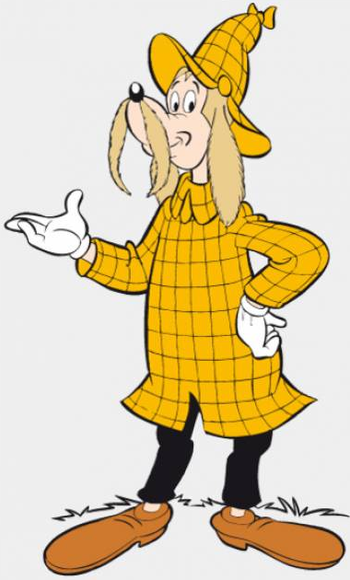
An ace detective who sometimes is called in to help with a case and sometimes just happens to find Mickey Mouse on his path.
- Affectionate Parody: Of Sherlock Holmes.
- Demoted to Extra: Shamrock Bones's last story was published in 1984. Since then, he's only appeared in riddle-type comics and illustrations.
- Deus ex Machina: Occasionally becomes this when he appears out of nowhere (in disguise) and saves Mickey and co. from circumstances they otherwise wouldn't have survived.
- Good Smoking, Evil Smoking: He used a pipe in his early appearances, but lost it in the late 80s. He stores a collection of pipes in his coat and picks them based on what kind of crime the case he's working on is about. He also has one pipe filled with a truth-telling concoction he can blow at criminals.
- Master of Disguise: Starting his second appearance in "The Mysterious Pill Plot". He tends to show up unexpectedly in whatever disguise suits the situation.
- Surveillance as the Plot Demands: He's got a detectograph that can calculate an answer to any question posed to it. It is advanced enough that, in "Invaders from Hootowl Hollow", it decided that Emil Eagle had to be behind the crime. When the question was repeated with the data that it couldn't be Emil (as he was in jail), the detectograph insisted it was Emil. Mickey checks up on the crook and discovers he's escaped two weeks ago, leaving a dummy to fool the guards.
- You Don't Look Like You: In the 1954 comic "The Mysterious Crystal Ball", he might as well be another character.
Brick Boulder

An officer from Texas who is not that bright and a little gung-ho, but possesses a good sense of justice.
-
 Badass Decay: When he first appeared, even the Phantom Blot was terrified of him, and Pete admits he's the only criminal who ever escaped him only because of sheer luck, but in later appearances he doesn't come up as the infallible cop of his debut anymore. Justified as in Mouseton he doesn't get as much action as he used to in Texas, being forced in investigations he's just decent with rather than jumping criminals caught in the act (something he's exceptional at).
Badass Decay: When he first appeared, even the Phantom Blot was terrified of him, and Pete admits he's the only criminal who ever escaped him only because of sheer luck, but in later appearances he doesn't come up as the infallible cop of his debut anymore. Justified as in Mouseton he doesn't get as much action as he used to in Texas, being forced in investigations he's just decent with rather than jumping criminals caught in the act (something he's exceptional at). - But Not Too Foreign: His family is of Italian descent, and his great-grandfather still lives near Matera
 .
. - Character Check: Once in a while he still gets the chance to just jump the perp... And demonstrates why Phantom Blot is terrified by him.
- Characterization Marches On: Debuted as basically a Lighter and Softer Harry Callaghan before becoming friendlier and boisterous.
- Everything is Big in Texas: His design alone is enough to fit the trope, never mind his boisterous personality.
- Those Two Guys: Sometimes forms this with Detective Casey.
- White Sheep: Brick's entire family consists of crooks. Not bigtime crooks, mind you, most of them are only wannabe criminal or involved with minor offenses. Still enough for the lot of them to be shocked when Brick announced he'd become a cop.
Armed Forces
Gloomy
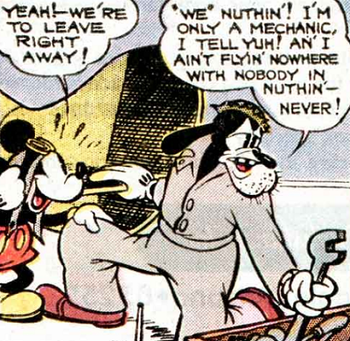
A mechanic under command of Captain Doberman. He's got the skill to be a pilot, even being the one who taught Mickey how to fly, but he prefers to be a mechanic because it's safer.
- Deadpan Snarker: With extra accent on the "deadpan". Most of his snark relates to people not going to come back from dangerous mission, even if those people include him.
- The Determinator: In his own low-energy, deadpan way. He's going to complain and make horrible predictions about what's going to happen, but he's not going to let it stop him either.
- The Eeyore: Well, his name is "Gloomy" ... and boy, does he ever live up to it.
- Related in the Adaptation: In some translations, like the Danish ones, Gloomy is a cousin of Goofy. Which works pretty well thematically.
- Trickster Mentor: Gloomy was Mickey's pilot instructor during preparational ground practice. The first thing he did was make Mickey cross a wooden beam promising him it'd hold as he'd already tested it himself. It didn't. Gloomy then explained the agitated Mickey never to fly a plane just because someone else tells you it'll fly; always check it over yourself.
Colonel Doberman

Colonel Doberman, previously Captain Doberman, was Mickey's instructor in becoming a pilot. Mickey later rescued him and several other captured pilots, after which Doberman regularly turned to him for special missions.
- Distressed Dude: Happens pointedly in "The Mail Pilot" and "Scoundrels in Space!". Mickey saves him in both cases.
- Informed Species: For the first two years of his appearances, he looked nothing like a Doberman Pinscher. He got a redesign in "The Pirate Submarine".
- Rank Up: He became a colonel shortly before the events of "The Ghost Town Airport", having been a captain prior. Disney's Mickey Mouse Adventures maintained the rank-up in "Scoundrels in Space!".
- Reasonable Authority Figure: He completely trusts Mickey to go on missions for him.
- Straight Man: He's mostly there to deliver the set-up for Mickey's punchlines or feats of daring-do.
- Theme Naming: With General Schnauzer and Major Beagle. Title, no forename, and a dog breed as last name.
General Schnauzer
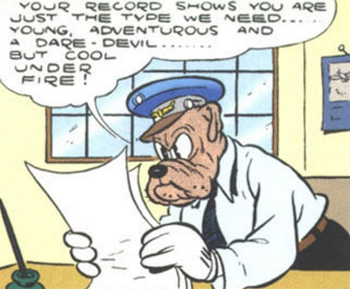
The head of the army's air mail division.
- Expy: Goes a bit back-and-forth between him and Colonel Doberman. Schnauzer takes over from Doberman as Mickey's superior officer when the latter is captured. However, he is the one to thank and award Mickey, a task performed by Doberman in the art piece Gottfredson made of the story.
- Reasonable Authority Figure: He's highly welcoming of Mickey when he joins the air mail service, warns him the time for joining is not ideal what with several pilots having already disappeared and gives him a chance out, and later fully trusts him on what to do to handle the threat.
- Theme Naming: With Colonel Doberman and Major Beagle. Title, no forename, and a dog breed as last name.
Major Beagle

The Command-in-Chief of the National Secret Service.
- Reasonable Authority Figure: The secret test aside, Major Beagle fully trusts Mickey to solve the case of the stolen blueprints and is nothing but supportive.
- Secret Test of Character: Inflicted one on Mickey because he wasn't fully convinced by Doberman that Mickey was reliable. He and his men dressed up in hoods, abducted Mickey right from Minnie's side, threatened him with death, and subjected him to Tickle Torture. Never did apologize for it either.
- Theme Naming: With Colonel Doberman and General Schnauzer. Title, no forename, and a dog breed as last name.
Performers
Professor Cicero Webster

A world-famous ventriloquist who works at or even owns the Bijou Theatre.
- Classy Cane: He's got one.
- Karmic Trickster: When Mickey pretended that Pluto could talk, Cicero immediately saw through the trick and told Mickey he had to be sure Pluto was the real deal. He asked the dog if he could really talk, at which point Pluto admitted to being a fake because Cicero was employing his own skill at ventriloquism.
- My Card: Both used as a sign he holds no ill will against Mickey and as a means to clue Mickey in as to what just happened.
- Vaudeville: A performer in this tradition, given his debut comic was written in 1936.
Foo Lee and Sue Lee
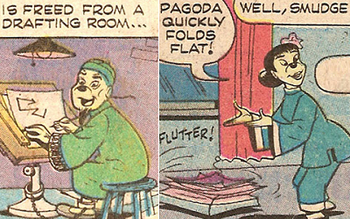
A father-daughter duo of engineer(s) and performer(s)
- Damsel in Distress: Combines with Distressed Dude, but the comic's emphasis is on Sue's troubles. The Crime King has abducted Foo to create decoys for him and Sue's been warned he'll be shot if she goes to the police. Her terror over her father's fate makes Sue barely able to continue performing, which insofar is fortunate because her crying afterwards cued Mickey in she's the one at the Pagoda Palace Restaurant he needed to talk to.
- The Engineer: At least Foo, possibly Sue. Foo's speciality is creating lifelike fold-up constructions using paper and bamboo. He's used his skill to create miniature buildings for disappearing tricks for Sue's performances, but the Crime King had him make to-scale buildings and vehicles to distract the population and make it easy for his men to commit plenty of robberies. When freed, Foo rewards Mickey and Goofy with a fold-up junk.
- Missing Mom: No Mrs. Lee is mentioned during the entirety of Foo being abducted.
- "Scooby-Doo" Hoax: The Crime King used Foo Lee's creations to disturb the citizens' attention away from his crime spree. The series included an extra five floors for the Drake Building that swayed in the wind and made it look the building would topple, the Cob Hill Mansion that burned down ten years ago and was presented as returning to do so again, and a blimp that seemed to be the crook's getaway vehicle but actually was a bomb intended to take out Goofy and Mickey.
- Stage Magician: At least Sue, possibly Foo. Sue performs at the Pagoda Palace Restaurant and her specialty are disappearing tricks for which she uses her father's inventions.
Sam Simian

An enthusiastic and talented robo-wrestler with a mean streak and poor sportsmanship, although Mickey has taught him to be a little more considerate.
- Alliterative Name: Sam Simian.
- Brain Uploading: Sam (and later Mickey) nearly gets his hypnotized brain stolen by Professors Ecks, Doublex and Triplex in "The Coming Of Quadruplex" to be incorporated in their robot army-controlling supercomputer.
- Cheaters Never Prosper: His fate during his first few appearances.
- Glory Hound: He will sabotage and attack a defenseless robo-wrestler if it improves his chances of winning. This is why only Mickey, who is used to his dirty tricks, is willing to be his opponent.
- Jerk with a Heart of Jerk: Slowly moving to Jerk with a Heart of Gold, but he's still perfectly capable of trickery and causing heavy bodily harm to feed his own ego a victory.
- Only Friend: Sam is a Jerkass, Mickey is the one with all the social skills. Or as Sam remarks in "The Robot Wrestling League": "Yipes! Mickey's in trouble! The only robot wrangler I ever knew with a good enough sense of humor to appreciate me!"
- The Rival: In his first appearance with Mickey. He alone maintains it in other stories but it grows weaker as he warms up to Mickey.
The Riverside Rovers

The soccer team Morty (8), Ferdie (10), and Gilbert (6) are members of. The rest of the team consists of Spike (7), Wally (11), Kevin (5), Pat (2), Mitch (3), Huskie (4), Nipper (9), and Sly (1). There's also a backup member named Sam (12).
- Academic Athlete: Gilbert is the team's brains.
- Mentor Archetype: The coach combines subtropes Badass Teacher, Token Adult, and A Father to His Men. In "Silent Witness", he beats up three criminals at once for threatening Sly, Morty, Ferdie, and Gilbert to the point they're glad when the cops come to take them away. He's the only adult consistently involved with the team, only rarely being joined by the kids' parents or Mr. Humbert, the team's sponsor. And he's a father figure, caring more about making his charges have fun and feel good about their efforts than about forcing them to victory. Morty and Ferdie learn the benefits of this approach in "Touch-Line Terror" when they see the coach of the other team practically terrorize the players.
- No Name Given: The coach is only known as the coach.
- The Quarterback: Mitch is the team captain. He's got a temper the rest sometimes has to protect him from, like in "The Homer", but no one disputes his position.
- Unnecessary Roughness: Sometimes pulled by the Opposing Sports Team, such as in "Penalty Problems" and "The Homer".
- Wrong Side of the Tracks: As per "Silent Witness", Sly's from a bad neighborhood. He's got a loving home, but he knows poverty and the rules of keeping secrets. He also has several hideouts to flee to that only a few close friends in the same spot he's in know about.
Scholars
Heath O'Hara
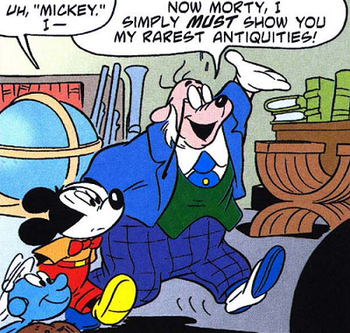
An antiquarian and collector who isn't above finding his wares himself. He is the cousin of Chief Seamus O'Hara.
- Absent-Minded Professor: He's eccentric, energetic, somewhat impulsive, and almost incapable of remembering Mickey's name.
- Accidental Misnaming: It isn't until the end of "The Sacred Spring of Seasons Past" that Heath gets Mickey's name right. Before that point, he's tried Morty, Manfred, Monty, Martin, Matthew, Mel, Moe, Max, Milton, Merrill, Mercer, Maynard, Marlon, Manuel, Moofus, Monticello, and Monteigo. He got Atomo's name right from the start.
- Adventurer Archaeologist: Heath's more of a historian, but ready to jump into action to commit to the trope if the prize catches his fancy.
- Collector of the Strange: Antiques aren't that strange to collect, but Heath goes at in a way that makes it hard to tell how reliable his collection is. For starters, Heath's ability to discern genuine antiques from fakes and things that don't even pretend to be antiques is hit-or-miss. In addition, his collection contains such peculiar pieces that it's hard to tell if they're supposed to be taken seriously, such as a scale model for the pyramids and the staircase from Admiral Nelson's flagship.
- Old Friend: With Bruto Filibuster, an equally Cloudcuckoolander-ish older man who works at the Aeronautics Museum.
- Opaque Nerd Glasses: Heath's eyes are only shown in moments of surprise, panic, or elation when his glasses jump up.
- Related in the Adaptation: In the original Italian comic(s), Heath is not related to Seamus, although he clearly does take design cues from him.
Prebbles Blackstone

An assistant curator at the Mouseton City Museum of Fine Art.
- Brainwashed and Crazy: Was threatened with this when Emil wanted to turn her, Shamrock, and Goofy into "human robots" by altering their personality. Prebbles's role in his large scale art theft scheme would've been to help him pick targets and to legitimize his robot statues to get them wherever there'd be loot.
- Damsel in Distress: Four people investigate the missing art pieces, Prebbles, Mickey, Goof, and Shamrock Bones. Who steps into one of the traps Emil Eagle has laid out and therefore gets taken prisoner first? Not one of the guys, that's who!
- Pink Means Feminine: Her entire outfits consists of pinks, give or take her black Nerd Glasses.
- Shout-Out: Prebbles Blackstone is named after Pebbles Flintstone from The Flintstones. The why probably has to do with "The Creepy Case of Ghost Rock Basin" being a Western Publishing era comic when Western Publishing at the time also produced comics for Hanna-Barbera properties.
Professor Rhinestone

A historian with expertise in jewelry. He's good friends with Minnie.
- Cane Fu: Implied, since he knew his cane'd make a useful weapon to Mickey.
- Cool Old Guy: Overlaps with Badass Bookworm. He and Mickey get into a minor clash of personality for the first ten or so minutes, but the moment the ninjas attack it's Rhinestone who gets Mickey a weapon to defend himself with. He also gets his guests out of the house the moment they can and gives them advice how to proceed next.
- Old Friend: To Minnie Mouse, whom he finds delightful company. At the time of "The Curse of the Cross-Eyed Kolli", they hadn't seen each other in years.
- One-Steve Limit: Averted. A Mrs. Rhinestone shows up in "The Gleam", who's evidently not related to Professor Rhinestone for starters because she's American and he's Dutch.
Archaeologists
Martina Ubersetzen
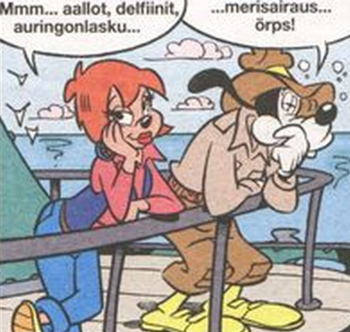
A colleague of Arizona Goof who occasionally joins him on expeditions.
- Action Girl: Depends a little on how much spotlight any particular comic wishes to give to Arizona (and Mickey in "Indiana Pipps e il tempio di cristallo"), but the trope gets mostly fulfilled.
- Adventurer Archaeologist: At least when she hangs out with Arizona.
- Dogged Nice Guy: They're friends and while Martina is romantically interested in Arizona, the feeling isn't mutual.
- Sidekick: When she is present, she is this to Arizona Goof.
Eurasia Toft

An up-and-coming archaeologist with a penchant for the kind of investigations that also are of interest to many less noble individuals. She can handle herself just fine against the worst of threats, but is always glad to find Mickey and Goofy on her trail to rely on in case the situation escalates.
- Action Girl: She'll jump into the fight alone if she has to because she's not going to stand by while thieves and vandals run off with history's gifts.
- Action Hero: Not a parody.
- Adventurer Archaeologist: If there's something exciting to be discovered or an ancient relic to be protected, she's the first to pack her bags and head out.
- Affectionate Nickname: Subverted. She was called "Lady Longtail" by Pedro, a member of her research team during her second adventure. As it turned out, Pedro was Pete and the nickname was part of charming her to trust him so he could eventually off her for his employer.
- Braids of Action: The reason for her nickname "Lady Longtail".
- The Engineer: She's very good with machinery, or at least vehicles. She once turned a broken helicopter into a working hovercraft (although she forgot to install brakes).
- Expy: For Lara Croft and Indiana Jones. Also something of a Distaff Counterpart to Arizona Goof.
- Friend to All Living Things: An action-science variant. It has saved her life on occasion.
- Granola Girl: Arguably what she was before going on her first expedition. Mickey explicitly refers to her as one.
- Hot-Blooded: With Genki Girl traits, but she's a little too serious for the latter. She has her Tranquil Fury moment when Pete mocks her for trusting him.
- Nerd Glasses: She's a brainiac and nearsighted. When on an expedition, she wears contact lenses.
- Never a Self-Made Woman: Her uncle's time as explorer served as her "in" to the world of archaeology.
Katarina Kodorofsky
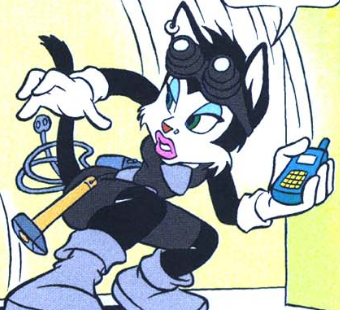
An international freelance agent who can be hired for matters involving historical artifacts and art. She's passionate about her work and prefers to work alone, but has found a reliable partner in Mickey Mouse.
- Adventurer Archaeologist: An unusual variant that does little research herself but is read up on others' research.
- Alliterative Name: Katarina Kodorofsky.
- Anti-Hero: Katarina has many traits usually given to a villainous character, but ultimately is a good person who does good.
- The Baroness: A rare variant on the side of good.
- Berserk Button: People stealing historical artifacts from the public to hoard for themselves or damaging them. Katarina is also very reluctant to destroy such objects herself, even when it's for the greater good.
- Brains and Brawn: Mickey is Brains (and Brawn), Katarina is Brawn (and Brains).
- Cats Are Mean: She's easily the most arrogant and readily provoked ally Mickey has.
- Claustrophobia: Things got terrifying when one villain tried to have her Buried Alive.
- First-Name Basis: Katarina goes from calling him "Mouse" to "Mickey" after he helps her through one of her weakest moments. She herself kept her last name hidden from him until a villain she had prior dealings with referred to her as "Kodorofsky".
- I Work Alone: Mickey is one of the extremely few people she's willing to team up with if it's absolutely necessary.
- Spy Catsuit: Depends on the coloring. It's a spy catsuit in all cases, but grey works a lot better for its function than red and yellow.
Scientists
Doctor Oofgay

A doctor who experiments with serums to change behavior in animals and people.
- Absent-Minded Professor: Oofgay does a lot of things that show lack of foresight. When he wants to demonstrate he can return a mountain lion to normal, he does not consider the fact it'll likely maul right after the injection and considers Mickey a spoilsport in regards to science. Sometime later, he does it anyway and gets mauled. Despite experimenting with serums, he's only brought a minimum of needles with him and mixes up two serums at a crucial moment. Then there's also this line: "That wass the second error of my career - The first one wass mistakink cyanide for salt!"
- Funetik Aksent: A heavy but not always hitting attempt at German-ish English.
- Mad Scientist: Not evil, but somewhat impulsive on his quest For Science!.
- Maniac Monkeys: The amount of simians that aren't maniac in Mickey Mouse comics is low.
- Third-Person Person: Not to himself, but to his concoctions, which he calls "Oofgay serums".
Doctor Einmug

An inventor and a friend of Mickey's.
- Floating Continent: Well, floating house, garage, and garden. Einmug built it himself so he could live in peace and keep his inventions safe from people with bad intentions.
- Flying Car: Einmug built himself one. It goes faster than any plane in existence.
- Funetik Aksent: An attempt to give his words a German flavor.
- Herr Doktor: Not much chance of him not being one with a name like "Einmug".
- Lack of Empathy: Shows this trait in "The Delta Dimension", where his comment on what happened between that story and his original appearance is "Mankid took my formulas and used them as they wanted. And in the meantime, I got a bit forward of that".
- The Maker: Of Atomo Bleep-Bleep and Atomo Bloop-Bloop in "The Delta Dimension".
- The Professor: He is an expert when it comes to atomic energy.
- Red Baron: "The Pioneer of the Atomic Age".
- The World Is Not Ready: Why he shares almost nothing of his discoveries. Considering what happened in the real world between his original appearance and his return in "The Delta Dimension" (something he actually alludes to) and what happens in the latter story when Pete gets his hands on the blueprints of some of his inventions, you can't deny he's right. In a variation, he knows the world will be ready one day, and takes an active role in accelerating said process by sharing some of his discoveries with trusted scientists while also keeping contact with Mickey in case someone manages to steal an invention he's not willing to share.
Professor Deeping Dustibones
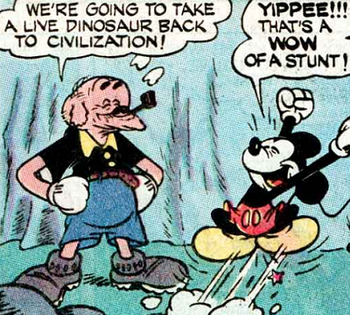
A paleontologist and occasional biologist and archaeologist who works at Dryupp University.
- Adventure Archaeologist: Adventure paleontologist, to be more accurate.
- The Bus Came Back: Dustibones was a Gottfredson one-timer until he suddenly got brought back in the 70s and became a properly recurring character in the 90s.
- Easy Amnesia: At the end of "The Land of Long Ago", it is revealed Dustibones has episodes of amnesia and that their length is random although usually limited to hours or days. This is used to justify why he won't be able to return to the dinosaurs' island to prove his findings, as this particular round of amnesia is permanent. Mind, this information about Dustibones comes out of nowhere and so far has only once, in "Lizard on the Loose", been picked up by new writers.
- Older Hero vs. Younger Villain: Dustibones and Wagstaff look about twenty years apart of age. More a matter of better vs lesser friend of Mickey than truly hero vs villain.
- One Degree of Separation: In "Love Trouble", Mrs. Van Astorocks happily receives Mickey Mouse to her party, who only got an invitation because of Madeline, because she's a close friend of Dustibones and has heard of his and Mickey's adventure together.
- The Professor: In paleontology, although his area of expertise has been stretched to include biology and archaeology to make him suited for more stories.
- The Rival: He and Professor Wagstaff exist on a fine balance of getting along and not getting along. The narrative does not necessarily side with Dustibones.
Doctor Biota

A professor on chemistry who temporary rented the top floor of Mickey's house.
- Inventor of the Mundane: Because Biota has needed bicarbonate of soda most of his life, his special invention is a machine that can induce flavor to the stuff. He soon finds a buyer for the product, at which point he can leave Mickey's house.
- Mistaken for Spies: Mickey comes to believe Doctor Biota to be a Nazi who is close to creating a Shrink Ray when he finds some papers on it. The papers, however, are the doctor's scifi manuscripts he produces for a magazine to fund his research now that he's no longer employed at the university.
- Or Was It a Dream?: The doctor did not actually make a Shrink Ray, right? And Mickey and Goofy never met the population of a soda atom, right? And they never got sent back to their own plain by the atom's scientists, right? It was all the result of a misunderstanding and the delusions created when Mickey and Goofy fell down the stairs, right? Then how come Goofy had part of the growth ray's machinery wrapped around his ankle?
- The Professor: On chemistry.
- Sleepwalking: Biota does this. Played for Laughs when Mickey tries to steal (what he thinks is) incriminating evidence and gets away with it by pretending he's sleepwalking, which the doctor is understanding towards because of his own experiences. Back in his room, he places the papers in a drawer, pleased with his ingenuity. Cue Biota actually sleepwalking in and stealing the papers right back.
- Stealth Hi/Bye: Doctor Biota has the remarkable and thoroughly unintentional talent to move about silently. He gives Mickey more than a few scares when he walks up to him to ask for bicarbonate of soda for his nervous indigestion.
Professor Zachary Zapotec

An archeology professor who often sends Mickey and Goofy back in time to investigate historical mysteries.
- The World Is Not Ready: They keep the time machine a secret because they are perfectly conscious of how the technology could be abused.
- Time and Relative Dimensions in Space: The time machine can technically be used as this, but the homing technology is not sophisticated enough yet.
- Time Travel: Marlin invented a time machine.
- Vitriolic Best Friends: With Marlin. They spend most of the time insulting each other, but in the end they're great friends.
Doctor Spike Marlin
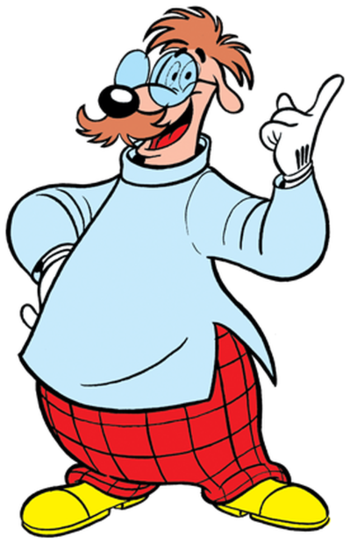
A physicist from Mouseton's college who often sends Mickey and Goofy back in time to investigate historical mysteries.
- The World Is Not Ready: They keep the time machine a secret because they are perfectly conscious of how the technology could be abused.
- Time and Relative Dimensions in Space: The time machine can technically be used as this, but the homing technology is not sophisticated enough yet.
- Time Travel: Marlin invented a time machine.
- Time Police: His rules about time travel insure Mickey and Goof don't need their intervention, and even have them occasionally act as this. In his later years he'll establish the actual Time Police of the Disney Comic Universe.
- Vitriolic Best Friends: With Zapotec. They spend most of the time insulting each other, but in the end they're great friends.
Professor Blubber
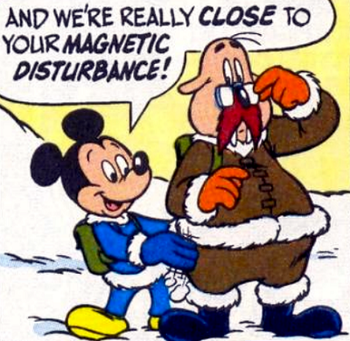
A scientist employed at the Geographic Institute.
- Friend to All Living Things: His introductory pages contain a page worth of panels on treating animals with respect. It's there to create a counterpoint to the comic's villain, Great White Hunter Wiley Wildebeest.
- Warm-Hearted Walrus: One could even mistake him for a dogface because his tusks are regularly (half)hidden behind his moustache.
- You Leave Him Alone!: Blubber utters the "Pick on someone your own size!" version to Wildebeest in defense of Mickey during their first fight with the hunter. It doesn't go down well, but from Wildebeest's words it would not have gone down well no matter what Blubber would've done.
Doctor Skott

A scientist involved with the national space program.
- Big, Stupid Doodoo-Head: The wittiest he manages to call the hijackers is "Rats! Nogoodniks! Philistines!". The unwittiest is "hijackers!". Needless to say, "Cheshire" Charlie is hit by none of it.
- Gone Horribly Right: Skott's weather-control laser, which he considers the masterpiece of his career, allows control of the weather. With "the most powerful and sensitive laser ever built". From space. It never occured to him that that particular design might be open to backfiring, as it proved to be right at launch when it was hijacked by "Cheshire" Charlie and he threatened to evaporate the world's oceans if his demands weren't met.
- No Sense of Humor: Not when it comes to his work anyway. Mickey's joke request that the new weather-control laser be used to guarantee him and Minnie no rain at an outdoor concert got a laugh from Colonel Doberman, but rather not from Doctor Skott.
Professor Wagstaff

A paleontologist and occasional biologist and archaeologist who works at Huxley College.
- Adventure Archaeologist: Adventure paleontologist, to be more accurate.
- Didn't Think This Through: In "The Fossil Hunters", he used dynamite to get easy access to dinosaur fossils so he could further his genetic experiments to revive dinosaurs. Both the critters and dynamite were kept in a complex he did not use the best resources for to keep the costs manageable. Cue a spark from the equipment igniting the dynamite and setting the dinosaurs free...
- Fossil Revival: He brought dinosaurs, specifically dromaeosaurs, back to life from the fossils he gathered. They view him as a parental figure.
- The Maker: Of herbivorous dromaeosaurs.
- Never the Obvious Suspect: In "Pluto's Nose Knows", Wagstaff completes a translation on the true story of the Golden Fleece and before sleep time reveals only a few things, such as that Jason remarks he wished he had brought along a dog. The next morning, Wagstaff and Pluto are gone. They were actually both abducted by the foreman.
- Older Hero vs. Younger Villain: Dustibones and Wagstaff look about twenty years apart of age. More a matter of better vs lesser friend of Mickey than truly hero vs villain.
- The Professor: In paleontology, although his area of expertise has been stretched to include biology and archaeology to make him suited for more stories.
- The Rival: He and Professor Dustibones exist on a fine balance of getting along and not getting along. Although Wagstaff is given the role of antagonist, the narrative is not necessarily against him.
Cosmo "Doc" Static

An inventor and a friend of Mickey's. He owns a cat named Alexander.
- Absent-Minded Professor: In one story, facing the prospect of a passing-by alien fleet vaporizing Earth, he starts to muse on the differences between human (mouse?) and alien systems of ethics, to Mickey's understandable frustration.
- Agent Scully: "The Santa Skeptic" shows that he does not believe in Santa Claus. He is, of course, shown the error of his ways.
- Been There, Shaped History: In "First Mouse in the Moon", Doc Static's great-great-grandfather, Bedford Static, is said to have been friends with H. G. Wells and inspired The First Men in the Moon.
- Expy: In most stories he appears in he is rather transparently the Mouse Comic equivalent to Gyro Gearloose in the Duck Comics. Crossovers have shown the two of them having a friendly rivalry and the Mythos Island story arc ended with them working together. Doc's primary distinguishing feature seems to be that he is a bit less of a Gadgeteer Genius and a bit more of an actual academic, but whether this is emphasized depends on a story.
- Mr. Fixit: He's great with machines.
- The Professor: He is a scientific genius.
Estrella Marina

A marine life expert.
- Friend to All Living Things: At least when it comes to marine fauna.
- Informed Species: She's a fox and reasonably if ambiguously looks like one on her own, but she looks nothing like any other foxes to ever share a panel with Mickey Mouse.
Aristocrats
King Michael XIV and Queen Phylline
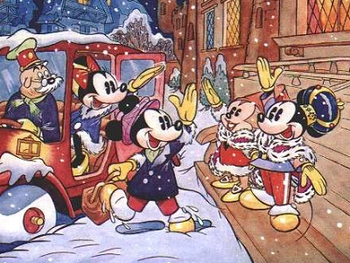
The royal couple of Medioka. Michael and Mickey are indistinguishable in appearance. Duke Varlott is Michael's cousin.
- Break the Haughty: Both Michael and Phylline go through this. After being abducted, nearly losing the throne to Duke Varlott, learning his people hate him because he's a selfish ruler while Mickey in mere days managed to become beloved, and owing his good ending to commoners Mickey and Minnie, Michael takes a hard look at himself and strives to be a better person. Phylline already disliked Michael's selfish attitude to kingship, but she too did not regard commoners as people per se and imagined herself above consequences until she learned what Mickey and Minnie had done for Medioka.
- Covered in Kisses: After being informed of Michael's and Mickey's switcheroo, Phylline gives Mickey a final kiss in gratitude, which leaves a mark on his cheek. Michael joking calls it "a decoration - ze Royal Order of Queen Phylline". Minnie is fine with it until in the coach home Mickey still hadn't wiped it off.
- Honor Before Reason: In Medioka, there is a law that any commoner who sits on the throne must be executed. Mickey was not informed of this when he accepted to switch places with the king. Despite his contributions to saving the country and the bond of friendship he'd built with the royal couple, Mickey was not going to be spared death by Michael on reasons that the king can't just let the law depend on his whim and favor. Mickey and Minnie are incredulous this is how their adventure should end, but Phylline and Count de Sheckels compliment Michael on his strength of character. Fortunately, Count de Sheckels had thought ahead and switched out the throne for a fake, so Mickey can live.
- Identical Stranger: Michael, Mickey, and Minnie. Michael's and Mickey's likeness sets the plot in motion, while Michael's and Minnie's likeness causes her to discover Michael's whereabouts.
- Love Triangle: While Mickey had to pretend he was Michael, he also had to manage Phylline's belief he was her husband-to-be and Minnie's involvement in the plan to save Michael.
- My Nayme Is: "Phylline" is "Feline". Notable in that it's one of the very few names in the Mouseverse that "hides" the animal.
- Prince and Pauper: A theme in both "The Monarch of Medioka" and "Topolino e il ritorno di Re Sorcio".
- Royal Brat: Michael and to a lesser extent Phylline. They're not children, but they are youthful.
King Tapiocus VI and Duke Feline

Respectively the king of and the heir to the throne of Mazumia.
- Break the Haughty: A minor part of Tapiocus's and Feline's ordeal that gets overshadowed by their treatment of Mickey. After they are cured, they immediately assume the worst of Mickey, who has risked his life to give them theirs back, and display an attitude towards him that's well in the area of "haughty". Only after they've returned to the embassy and spoken with the royal advisors do they understand what has happened and that their treatment of Mickey was severely misplaced. Tapiocus quickly goes back to beg for forgiveness.
- Fountain of Youth: Over six months before the events of "The Mystery of Tapiocus VI", one Professor Stoltz's research into a rejuvenation medicine had yielded him a pill to make someone mentally a child again and a pill to undo that effect. Then he died and a crook named Swifty managed to get his hands on the pills.
- Identical Stranger: Overlaps with Criminal Doppelgänger for Duke Feline. Pete is his, which gave Swifty the idea to feed the mentally de-ageing pills to King Tapiocus VI and Duke Feline so Pete could take the latter's place and the former would easily be bullied away to grant Pete all power. It was a foolproof plan but for the freak coincidence that Tapiocus ended up in Mouseton and met Mickey.
- Pre-Insanity Reveal: Tapiocus did tell Mickey and Goofy about his Mazumian origins and his dealings with "the regent", but neither took him seriously. Then Tapiocus gave Mickey his piggybank to bail him out and the coins inside showed that Tapiocus really was Mazumian royalty. He and Duke Feline are later cured from their mental age predicament.
Princess Uina Uì and Pinky Pack
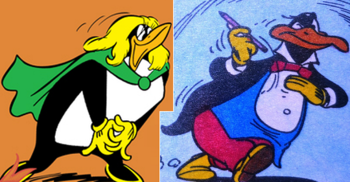
The daughter of King Burbero and her fiancé, who is Captain of the Guard but a commoner. They weren't allowed to marry at first, but eventually the king changed his mind. Pinky Pack has a Secret Identity as the Masked Pretender.
- Doomed Hometown: Uina and Pinky belong to the penguin civilization of the North Pole, which is highly advanced due to the presence of ultra-ice. Research by Professor Neutron causes a volcanic eruption that makes the ultra-ice inaccessible and destroys the penguins' way of life. They opt to move to their peers on the South Pole.
- Frame-Up: Uina's first fiancé, an unnamed nobleman who didn't seem very bright, used the Masked Pretender identity to try to kill King Burbero and get the throne early while the real Masked Pretender would face the blame. Mickey uncovered his plot, which then got him engaged to the princess.
- Pantsless Males, Fully-Dressed Females: Inverted. Uina walks around only in shoes and cape, while Pinky is fully dressed.
- Praetorian Guard: Pinky is the Captain of the Royal Guard of Penguinia. One of his tasks is ensuring that any outsider who learns of the secret of ultra-ice is brought to Penguinia to live out their life as forced citizens.
- Secret Identity: The Masked Pretender is Pinky Pack's means to do his job outside of the constraints of the law, but it was also used by an unnamed nobleman to attempt crimes the real Masked Pretender would be blamed for. Pinky created the secret identity in response to his frustration over his and Uina's love being forbidden.
Acquaintances
Snake and co.
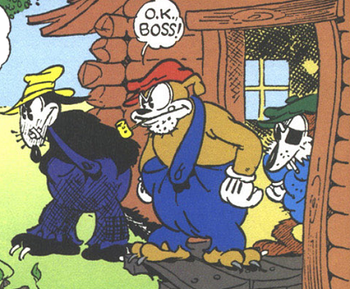
Butch's two co-crooks with whom he formed a gang that had Mr. Slicker as their boss. Snake is the other big guy, while the short one goes unnamed.
- Affably Evil: Okay, so the three robbed a bank and eggs and overall are involved with robbery, but they're a pleasant bunch to hang with as Mickey discovered. Even the more aggressive Snake wasn't anywhere near bad with Butch as his shoulder angel. They even helped Mickey stop the wedding between Slicker and (the unwilling) Minnie after he convinced them Slicker wasn't going to pay them.
- Chuck Cunningham Syndrome: Although not as kind to Mickey as Butch, his friends were not worse people and they clearly got along well with Butch. Unlike Butch, they never returned to feature in another story, as if Butch never even knew them.
- Eyepatch of Power: The short crook wears an eyepatch on his left eye. He's sometimes drawn without it, which could go either way if he doesn't need it or if it's an art error.
- No Name Given: The short one of the gang did not get a namecheck.
- Pointless Band-Aid: Snake has a band-aid on the side of his snout. Which side depends on the panel, as it's always visible.
- Terrible Trio: Formed by Butch, Snake, and the other guy. Could somewhat argued to be Combat, Diplomacy, Stealth in the order Snake, Butch, and the other guy.
Dan

The dogcatcher of Mouseton. He regularly chases Pluto and sometimes gets in conflict with Mickey over it.
- Ambiguously Evil: Being a dogcatcher (with questionable methods) marks him as mean at most, but when he realizes his error in going after Pluto in "Pluto and the Dogcatcher" and having to deal with a distraught Mickey, he ponders that he's too soft and that he should consider another career, like robbery.
- The Atoner: In "Pluto and the Dogcatcher", he learns that Pluto does have a license and that he chased him away from his owner. He feels guilty over this and promises to find and bring back Mickey's dog.
- Cats Are Mean: He is a cat and is not a pleasant person at all. Double points for being a cat who is mean to dogs specifically.
- Diabolical Dog Catcher: It depends on the story, but is true in about half the cases.
- Handicapped Badass: His peg-leg. He only had it while Gottfredson wrote his stories. Bill Walsh gave him two regular legs. There does not appear to have been any particular reason for this like there was with Pete, as Dan never was prominent enough to create confusion. Gottfredson consistently portrayed his peg-leg to be on the left side, which, incidentally is a halfway decent difference between Dan and Pete, whose peg-leg by origin is on the right side.
- Out of Focus: Dan stopped appearing after the 50s.
- Right-Hand Attack Dog: Dan owns three dogs to help him do his job. One's a nameless female dog that lures other (male) dogs to Dan for catching, the other two are guard dogs named Franz and Hanz who use brute force and intimidation to catch the target.
- Suspiciously Similar Substitute: That or Depending on the Artist. Dan originally appeared in two comics in 1932 and 1933, written and drawn by Gottfredson. It's obvious on the whole front, but the peg-leg is a dead giveaway that Dan is a stand-in for Pete. He may very well have been meant to be Pete before a last-minute decision. Several translations have even presented him as Pete, trying his hand at an honest job. After that, he didn't return until Walsh revived him in 1949. That is, the character that's definitely Dan is, as drawn by Manuel Gonzales. But "another" corpulent cat dogcatcher became a regular four years earlier in 1945, again as written by Walsh but as drawn by Gottfredson. It's possible this dogcatcher is Dan too, redesigned by Gottfredson to differentiate him from Pete.
Mortimer Mouse note

One of Mickey's rivals for Minnie's affections. One of several Mickey Mouse characters carrying the name Mortimer, others being Minnie's uncle and Mickey's nephew.
- Alliterative Name: Mortimer Mouse.
- Catchphrase: In Mickey Mouse Works and House of Mouse, Mortimer had a tendency to respond to unusual situations with "Hot-Cha-Cha!". This has since made its way into the comics, such as in "King of the Bungaloos Strikes Back". An additional minor inspiration from the show is Mortimer calling others "Fickle Freddy". First uttered in "Mickey's Mix-Up", it returned in "The Man That Wasn't There!".
- Dirty Coward: When danger lurks, Mortimer is more than happy to throw everyone else at it in order to save himself — even Minnie, and even if he was just trying to court her moments before.
- Expy: Combined with Composite Character and Decomposite Character. In 1930, Gottfredson wrote "Mr. Slicker and the Egg Robbers" which introduced the first "Mortimer-esque" character: Mr. Slicker. Then in January of 1936 Gottfredson was involved with "Mickey's Rival", the comic that introduced Mortimer Mouse himself and was followed with an animated version in June. Lastly, 1941 saw the publication of "Love Trouble", scripted and sketched by Gottfredson. This comic debuted a third "Mortimer-esque" character: Montmorency Rodent. Gottfredson treated them as separate characters because each of them had to be introduced to Mickey in their debut comics. Translations and later comics to feature these characters often differ in approach and present the three as the same or interchangeable. "Mortimer Mouse" is considered the default identity but he regularly gets drawn in the likeness of Montmorency.
- The Friend Nobody Likes: Minnie generally likes him, or something that can with some lenience be called that, but the trope's in effect for everyone else when Mortimer isn't straight-up played as an antagonist. Illustrated nicely by the cover art of Topolino #3075.
- Hate Sink: His role in stories is basically to be a prankster and borderline bully towards Mickey, so that he can get his comeuppance in the end. Characterization Marches On, though, and some modern comics portray him as an unlikely ally or even tough friend.
- Jerkass: Pretty much all he does is pick on Mickey and try to get into Minnie's pants, even when Minnie makes it clear that she is only interested in Mickey.
- Miles Gloriosus: He'll be bragging up a storm about his own strength and courage, but as soon as things don't go his way, he'll be the first to turn tail and run.
- One-Steve Limit: Averted. There's another Mortimer Mouse, who is Minnie's uncle. There's also a Mortimer Fieldmouse, who is Mickey's nephew.
- The Prankster: As mean-spirited as you can imagine. Think "cuts apart Mickey's clothes while he's over for dinner at Minnie's".
- Rich Suitor, Poor Suitor: Mortimer being the rich one, and Mickey being... well, you know.
- Writers Suck: He dabbles in writing scripts for shows and movies, and is quite poor at it:
- In one story he and Mickey replace Moffetta, the missing writer of the popular and long-running detective series "Bolton", with Mickey as the main writer and Mortimer as the assistant... And Mortimer, owing to his ability to get the producer to listen him, proceeds to make non-sensical alterations that lead to Mickey quitting (soon followed by the main actor and director, that Mortimer replaces with himself) and going to look for the old writer to save the show. As Moffetta had faked his disappeareance because he, the main actor and the director were sick of "Bolton" and wanted to make another show but the producer wouldn't listen them, Mortimer's "Bolton" is canceled at the first episode of Mortimer's "Bolton Reloaded", as the sponsors have seen he has lost them the entire target audience and pull the funding... To instead produce Moffetta's new show after seeing the pilot (produced with the help of Mickey and friends). And as there was still just enough funds to produce one last "Bolton"'s episode, Mortimer is forced to take part in it and have his version of Bolton exposed as an imposter by the original before being kidnapped by a Martian robot (one of Mortimer's characters) that is going back home.
- In the "Darkenblot" saga Mortimer wrote the script for the in-universe film based on the events of the second story. While popular, it's a terrifying and nonsensical Cliché Storm that Minnie loves only because Mortimer added her to the story and turned Mickey's female ally into a villainous robot. Mickey, on the other hand, is disgusted (and remarks he had recognized the style when he finally learns who the writer was)... And Phantom Blot is incensed for his portrayal in the film.
Former sergeant

A sergeant for the MPD who got demoted after messing up a case and went into acting.
- Miles Gloriosus: His characterization in "The Seven Ghosts". He claims the Bassett Estate doesn't have any ghosts because he went to make sure of that. A moment later, another officer hands him the gun and hat he'd lost jumping through the window at the sight of the ghosts, which Colonel Bassett had sent him along with a bill for the glass.
- Sore Loser: Morphing into Graceful Loser. In "The Seven Ghosts", his thing was to be a glory hogger even though he'd done little to earn it. Most of the story's ending humor revolves around Colonel Bassett losing his patience with the man, kicking him out, and forbidding him from ever returning. The sequel "The Mystery of Freefer Hall" establishes the sergeant was demoted afterwards and spent some time patrolling in Donald's neighborhood before disappearing, which Donald liked just fine because he was sure the former sergeant was out for revenge. As it turns out, that was true, but he disappeared because he found a new career in acting and he no longer holds any grudges, regarding the events of "The Seven Ghosts" as an amusing artifact of the past.
- Never the Obvious Suspect: In "The Mystery of Freefer Hall", because who else but someone with a personal grudge would try to burn down Bassett Estate? Not to mention he made a point of keeping a distance between himself and Mickey, Goofy, and Donald. Turns out he did that to not endanger his performance.
- No Name Given: Two stories and still no name. There are characters worse off, but it's still sad.
Joe Piper and co.
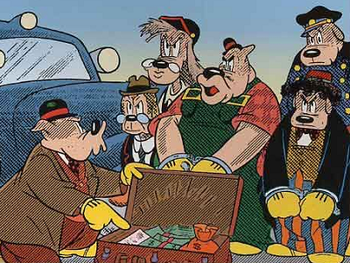
Joe Piper, Mr. Dibble , Mr. McKatz, and another man are a quartet of stage actors who had to resort to crime when the seats stayed empty. Their acting skills proved useful in setting up a scheme to commit a great number of robberies.
- Affably Evil: The four aren't exactly hardened criminals and to some extent they are relieved to have been caught by the police. They readily cooperate to close the case snappily (to the point the police complains they don't get to do their job this way) and spend the extra time this nets them to plan what plays they'll perform for their fellow prisoners. Before being sent off to jail, Joe Piper addresses Mickey to tell him there's no hard feelings because Mickey only did what he had to do and that he looks forward to be visited in prison.
- Cultured Badass: Joe Piper isn't violent, but he's clear about his strength and size in several confrontations.
- Do-It-Yourself Plumbing Project: Joe Piper doesn't do his own plumbing, but he has very limited experience and makes a mess of his customers' plumbing. There's some ambiguity if his initial incompetence is an act to draw away suspicion or if he's truly unbothered about making showers that are only a meter high because he's out of pipes or bending long pipes to fit small distances.
- Gentleman and a Scholar: All four of the group.
- Get-Rich-Quick Scheme: Not quite "quick", but still faster than what honest work would give them. With the times changing, the four stage actors stopped being able to provide for themselves. However, they knew a city commissioner who wanted to start an acting career himself, so they gave him lessons (that paid off). In exchange, he appointed Dibble as a building inspector. Dibble then arranged for McKatz to get work as a general contractor, Piper as a plumber, and the other one as the watchman at the city bank. Dibble would use his position to condemn houses so McKatz and Piper could move in on it and make the house easy to break into for the watchman, who had a not-so-bright friend cover his shift at the bank on the excuse he was visiting a girlfriend. The watchman was kept out of the bureaucratic aspects of the plan so the police would not suspect him to be part of the gang while Piper and Dibble played the incompetent plumber and the building inspector fed up with him to further divert suspicion. The rich houses they robbed were a preparation for the bank robbery, which would double as their grand escape.
- Master Actor: Overlaps with The Power of Acting. Mickey only realized all four crooks were involved in the robberies when their scheme neared completion and neither he nor the police ever suspected them to be actors.
- No Name Given: Joe Piper is the only one whose full name is given. Dibble and McKatz have to do with a last name only. The watchman didn't get a name at all.
- Starving Artist: The reason they turned to crime. They used to enjoy great successes, but at some point the audience did not return for them.
Montmorency Rodent
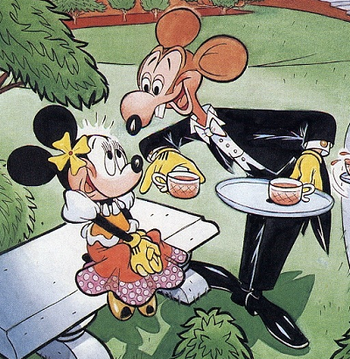
One of Mickey's rivals for Minnie's affections. He's the chauffeur of a man whose possessions he sometimes borrows-without-asking to look better. The character as originally written fits more as a half-villain than an acquaintance, but it's practical to keep Montmorency's entry nearby Mortimer's due to the two characters having been merged since.
- The Butler Did It: "The chauffeur did it", or "it is the chauffeur", but same difference.
- Expy: Combined with Composite Character and Decomposite Character. In 1930, Gottfredson wrote "Mr. Slicker and the Egg Robbers" which introduced the first "Mortimer-esque" character: Mr. Slicker. Then in January of 1936 Gottfredson was involved with "Mickey's Rival", the comic that introduced Mortimer Mouse himself and was followed with an animated version in June. Lastly, 1941 saw the publication of "Love Trouble", scripted and sketched by Gottfredson. This comic debuted a third "Mortimer-esque" character: Montmorency Rodent. The likeness between the three is obvious, to the point one scene in "Love Trouble" appears set up solely so Goofy could say "Boy, I'll bet y' showed that slicker, Monty, up! Heard yuh played some kinda egg trick on 'im!" which evokes "Mr. Slicker and the Egg Robbers". However, Gottfredson treated them as separate characters because each of them had to be introduced to Mickey in their debut comics. Translations and later comics to feature these characters often differ in approach and present the three as the same or interchangeable. "Mortimer Mouse", the only one with an animated counterpart in the classic shorts, is considered the default identity but more often than not he gets drawn in the likeness of Montmorency in modern comics.
- Hate Sink: "Love Trouble" and "The Egg Collector", the latter of which has a rare English translation identifying "the Mortimer" as Montmorency, do not want you to sympathize with Montmorency. Then there's "The Coppers' Catch", which features a character named Mortimer Rodent! The character is closer to Montmorency than Mortimer and downright criminal, using a humiliation trick to get Mickey to unknowingly help him whitewash counterfeit money.
- In-Series Nickname: Everyone calls him "Monty".
- It's All About Me: How Montmorency carries himself. Every relation he has ultimately prioritizes him over the other. The end of "Love Trouble" features a Break the Haughty when he's publically outed at an important party as a fraud.
- Malicious Misnaming: He never refers to Mickey by his actual name. Monty's main nickname for him is "Jasper", followed by "Wilbur", and he's also gone for "Chauncey" and "Charlie".
- Pronouncing My Name for You: Montmorency's last name is "Rodent", which he insists is pronounced "Rodawn".
- Rich Suitor, Poor Suitor: Unlike Mortimer and Slicker, Montmorency only pretends to be rich as he flaunts with his employer's money. That still puts him in the role of the rich suitor to Mickey as the poor suitor.
- The Rival: To Mickey for Minnie's affections, although he doesn't know he's only being used by Minnie in an Operation: Jealousy. He also has an Unknown Rival in Millicent Van Gilt-Mouse, who is the real deal of what he wants to be.
- Stage Magician: Montmorency has considerable skill with magic tricks. One of them involved making a rabbit appear on Mickey's head, which the latter considered cheap.
Flappity McFlop

A former friend of Ellsworth. While the latter has cleaned up his act since the days they associated, Flappity has not.
- Black Mail: Years ago, Ellsworth and Flappity were colleagues managing the Molden Gate Bridge in Mausalito. Then an accident happened where the swing bridge closed while two ships were trying to get through that seemed to be Ellsworth's fault. Flappity urged him to scram, which Ellsworth did, never to hear of the follow-up investigation that found the machinery to be malfunctioning at the time of the accident. Flappity was sacked because on his own he was no good as an employee. When he meets Ellsworth again, however, he plays on Ellsworth's distorted vision on the disaster to convince him he's still wanted and that he himself was sacked for merely being active staff at the time. In return for his silence, Flappity gets Ellsworth to offer him food, a roof, and to go along with whatever Flappity wants, like gambling.
- Furry Confusion: Flappity could be mistaken for a regular person-animal, but his association with Ellsworth and ability to fly betray he's on the same could-go-both-ways scale. He appears to be a seagull.
- The Gambling Addict: With the possibility of either Professional Gambler or Fixing the Game. He forces Ellsworth into playing yuckzee with him "like [they] used to". Ellsworth loses an unclear number of times before the story moves elsewhere, which doesn't seem to surprise him.
- The Nicknamer: He calls Ellsworth "Ellzy".
- Old Friend: Not a good one, but he and Ellsworth do have a history together.
Zenobia II

The queen of a hidden county in Africa who seeks to conquer the entire continent. She wishes for Goofy to become her king. She gives up her dreams of conquest and her throne at the end of her first story to start a new life in Mouseton, where she and Goofy maintain an on-off romance until she moves to Paris.
- Affectionate Parody: Of Ayesha.
- God Save Us from the Queen!: Aside from her plans for conquest, her own people are forbidden from leaving unless they are sent out to fulfill a task.
- Love Redeems: Her love for Goofy is integral to her abandoning her plans of conquest.
- Love Triangle: Zenobia loves Goofy, who loves her back but not the tyrant part of her (which he's for the longest time oblivious too). Then there's her advisor Akar, who respects her but ultimately is more interested in her for the fact marrying her will make him king. He does not like Goofy, obviously.
- Meaningful Name: Romano Scarpa named and partially modeled her after Septimia Zenobia, a third-century queen of the Palmyrene Empire, known for slapping Rome in the face a few times.
- Mind Control: Zenobia and Akar have access to a syrup with which they can make others obey them. They have servants all over Africa in places where they can feed it to the various countries' leaders when the plan is to be set in motion.
- Race Lift: Zenobia is of Persian and African descent, which fits her original look in outfit and hair. Starting her second appearance, her hair became blond (brown once or twice) and starting her third appearance it lost its curls. With her fashion sense adapted to Mouseton life, she's stopped being recognizable as her original self.
- Take Over the World: Zenobia's plan in the long run.
Muscles McGurk
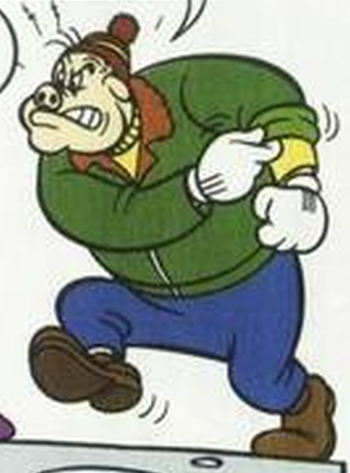
An aggressive neighbor of Mickey's that he doesn't get along with.
- Brains and Brawn: He and Montmorency Rodent formed this in "The Egg Collector", while he and Horace teamed up as such in "Which Way Winter". Muscles, obviously, was the brawn in both cases.
- Carpet of Virility: On display in "The Egg Collector".
- Cranky Neighbor: Very cranky. It's not a good idea to agitate someone named "Muscles".
- Expy: Of Donald's Neighbor Jones. Only, McGurk doesn't have the excuse of living next to Donald Duck.
- Pig Man: The physically strong, bullying type.
Michel Souris

A fan of Mickey Mouse who occasionally dips into dangerous obsession but mostly is a tiresome acquaintance. He's got a girlfriend named Micheline and an unnamed sister who has a daughter of her own.
- Breakout Character: Not a lot of post-1950 characters get to be promoted to title characters. Michel got the status in 2001.
- The Friend Nobody Likes: He is convinced to be Mickey's best friend and most trusted assistant, when Mickey can barely tolerate him at best.
- Lethal Klutz: Incapable of performing even the simplest task without disastrous results.
- Loony Fan: He sought to Kill and Replace Mickey in his debut comic as the ultimate expression of his devotion, which as per a 2006 comic got its start when his father gave him a copy of Mickey Parade back when he was a toddler. After that he's tried to pull off other wacky plans, like trying to break up Mickey and Minnie in "L'ennemie dans la maison" and following Mickey around to imitate him in a 2004 comic.
- Out of Focus: Michel's stories came to an end in 2009.
- Shout-Out: "Michel Souris" is the French equivalent of "Mickey Mouse". It actually was Mickey's own name in France for a short while, either in the first translations or during the absence of Le Journal de Mickey in 1944-1952. Furthermore, the relationship between Mickey and Michael as co-workers seems to be modeled after that of Fantasio and Gaston.
- Unwanted Assistance: Mickey usually begs him to keep away and mind his own business, but he always insists in helping, and it always ends up in disaster.
- Walking Disaster Area: He's an expy of Gaston Lagaffe, the biggest one in comics, what did you expect?
Madison King

A television tycoon who semi-unintentionally exploited Goofy for a while.
- Heel–Face Turn: For all her tricks, Madison was moved by Mickey's and Goofy's reunion. She acknowledged she'd been a heel and ended Goofy's involvement with the King TV Empire.
- Ignore the Fanservice: One occurs when she's on a date with Goofy and he talks about the flaws of the program offering on TV. In the midst of his rant, Madison asks if he likes her gown. His response?: "That's it! A game show where contestants hafta wear awful fashions! It can't miss!". Madison takes it in stride, reverting to boss mode for a phone call to get Goofy's idea on the air. The comment also doesn't stop her from wearing the gown on a later date.
- In-Series Nickname: Madison is also known as "Mad King" in the newspapers.
- Jerkass Has a Point: Even if "I know what's best for Lucky" was as much a distraction as it was sincere, Mickey forgoes his one chance to cure Goofy because he learns that his friend is, in fact, happy with his new life and returns Madison's feelings.
- Karma Houdini: Madison may not have meant (all that) badly and understandably was afraid to lose Goofy, but she did a lot of awful things. Once she discovered that Goofy, who was suffering amnesia, had an eye for what got audiences hooked, she hooked him. She nicknamed him "Lucky", explicitly noting she didn't care about his real name, and dragged out his offer to review her programs. She had no interest in seeing him cured and cultivated his new personality for her own gain and benefit. And when Mickey found out about Goofy's amnesia and came looking to cure him, she got dirty. Her employees were instructed to block any contact attempts by Mickey Mouse and she took Goofy on a vacation to further discourage the meddler. He came looking for them in Monkey Carlo anyway, so she planted a loaded deck on him and then alerted security. Mickey tried to reach Goofy again while skiing, prompting Madison to knock him off the piste when rushing him by. Mickey, badly injured, last showed up during a skydive, where Madison activated his parachute early so he'd lose distance, but it caused Mickey to land against Goofy's head some minutes later, restoring his memory. The touching reunion of the two friends finally made Madison back off, but she only lost Goofy because of it. The money she'd made and the new course of her cable stations and network remained hers while she paid off Goofy with a lifetime subscription to her 200 channel supersystem.
- Thrill Seeker: Madison's idea of vacation involves extreme sports, but she's also ready for dangerous activities if they're part of a Ratings Stunt when she'd otherwise never thought of it.
